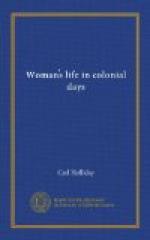And again, Hannah Adams’ Memoir of 1832 expresses in the following words the intellectual hunger of the Colonial woman: “I was very desirous of learning the rudiments of Latin, Greek, geography, and logic. Some gentlemen who boarded at my father’s offered to instruct me in these branches of learning gratis, and I pursued these studies with indescribable pleasure and avidity. I still, however, sensibly felt the want of a more systematic education, and those advantages which females enjoy in the present day.... My reading was very desultory, and novels engaged too much of my attention.”
After all, it would seem that fancy sewing was considered far more requisite than science and literature in the training of American girls of the eighteenth century. As soon as the little maid was able to hold a needle she was taught to knit, and at the age of four or five commonly made excellent mittens and stockings. A girl of fourteen made in 1760 a pair of silk stockings with open work design and with initials knitted on the instep, and every stage of the work from the raising and winding of the silk to the designing and spinning was done by one so young. Girls began to make samplers almost before they could read their letters, and wonderful were the birds and animals and scenes depicted in embroidery by mere children. An advertisement of the day is significant of the admiration held for such a form of decorative work: “Martha Gazley, late from Great Britain, now in the city of New York Makes and Teacheth the following curious Works, viz.: Artificial Fruit and Flowers and other Wax-works, Nuns-work, Philigre and Pencil Work upon Muslin, all sorts of Needle-Work, and Raising of Paste, as also to paint upon Glass, and Transparant for Sconces, with other Works. If any young Gentlewomen, or others are inclined to learn any or all of the above-mentioned curious Works, they may be carefully instructed in the same by said Martha Gazley.”




